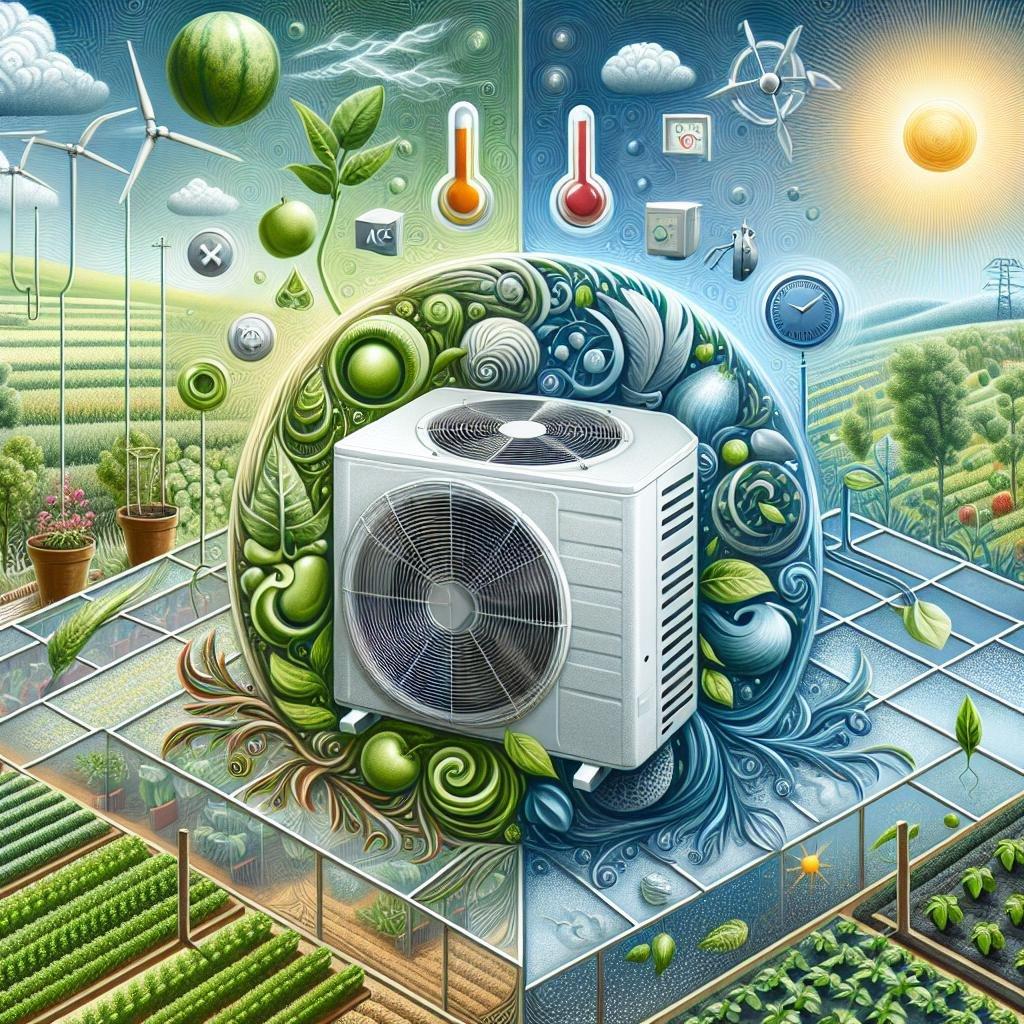As the sun rises over sprawling fields and verdant greenhouses, the delicate balance of nature and agricultural productivity comes into sharp focus. Among the many tools available to growers, mini split air conditioning systems have emerged as a vital ally, providing precise temperature control and optimized conditions for plant health. Though,the integration of these systems into agricultural spaces demands careful consideration. From energy efficiency to zoning capabilities, understanding the nuances of mini split AC technology can enhance both sustainability and crop yield. In this article, we will explore the key factors that growers and greenhouse operators should consider when implementing mini split AC systems, ensuring that each breath of fresh air contributes to a thriving agricultural habitat.
Optimal Sizing and Placement for Maximum Efficiency
Ensuring that your mini-split AC units are appropriately sized and strategically placed is crucial for achieving optimal performance in greenhouse and agricultural commercial spaces. Sizing should be calibrated based on factors such as the area of the greenhouse, the types of crops being cultivated, and local climate conditions. A system that is too small will struggle to maintain the desired temperature and humidity levels, while an oversized unit could lead to inefficiencies and inconsistent airflow. Key variables to consider when sizing your mini-split system include:
- Greenhouse volume and insulation properties
- Heat generated by equipment and sunlight exposure
- Specific cooling and heating needs of different crops
Placement is equally critical, as it can substantially affect airflow and temperature distribution. Position your units to facilitate even cooling and heating across the entire space, avoiding hotspots and cold spots that can distress plants. Ensure that the outdoor unit is located in a shaded area to enhance efficiency and durability. Consider external factors that may impede airflow, such as nearby obstructions or reflective surfaces. A strategic layout can maximize effectiveness and minimize energy consumption, leading to optimal environmental conditions for your crops. Here’s a simplified overview of effective placement strategies:
| Placement Strategy | Benefits |
|---|---|
| Mount units high | Promotes even air distribution |
| Avoid corners | Reduces dead zones in airflow |
| Stick to the south side | Maximizes sunlight shading for the outdoor unit |

Energy Consumption and Cost Savings Strategies
Implementing energy-efficient practices in greenhouses and agricultural commercial spaces can significantly reduce operational costs. Mini split AC systems are highly adaptable and boast advanced technologies that not only help maintain optimal temperatures but also minimize energy consumption. To maximize their efficiency, consider incorporating the following strategies:
- Optimize Placement: Position the indoor units strategically to promote even air distribution, reducing the need for excessive cooling.
- Utilize Smart Thermostats: Integrate programmable thermostats to automate temperature control, enabling you to adjust settings based on peak energy usage periods.
- Regular Maintenance: Schedule routine maintenance to keep the systems running efficiently, thereby preventing energy waste.
- Insulation Improvements: Enhance the insulation of your greenhouse or commercial space to minimize heat loss and improve system efficiency.
Establishing a clear understanding of energy costs and potential savings can aid in decision-making and budgeting.Here’s a simple comparison table showcasing potential monthly savings from utilizing mini split AC systems versus traditional cooling methods:
| cooling Method | Estimated Monthly Energy Cost | Potential Monthly Savings |
|---|---|---|
| Traditional AC | $350 | N/A |
| Mini Split AC | $250 | $100 |
By adopting these cost-saving strategies, you not only enhance the sustainability of your operation but also create a more comfortable and productive environment for cultivation.Implementing energy-efficient systems translates to long-term benefits that support both economic viability and environmental stewardship.

Maintaining Air quality and Humidity Control
Effective air quality and humidity control are crucial for optimizing growth and ensuring the health of plants in a greenhouse or agricultural commercial space. Mini split AC systems excel in providing precise temperature management, which inherently contributes to a stable environment. By maintaining ideal air circulation, these systems help prevent stagnation, a common issue that can lead to mold and mildew growth. It’s also important to monitor and adjust the humidity levels to prevent excess moisture, which can have detrimental effects on crops.
Implementing a few targeted strategies can enhance air quality and humidity control:
- Regular Monitoring: Utilize hygrometers and air quality sensors to keep track of humidity and temperature levels.
- Ventilation Management: Ensure adequate ventilation through controlled openings or exhaust fans that work in tandem with the mini split system.
- Smart Controls: Leverage smart technology to automate settings based on real-time environmental data, allowing for timely adjustments.
- Maintenance Schedule: Establish a routine maintenance schedule for the mini split unit to keep it functioning optimally and to maintain air quality.
Here is a simple overview of the essential components to optimize air quality and humidity control:
| component | Function | Importance |
|---|---|---|
| Mini Split AC | Cooling and dehumidifying | Essential for temperature regulation |
| Hygrometer | Measures humidity levels | Critical for monitoring plant health |
| Ventilation Fans | Enhances air movement | Prevents mold and diseases |
| Smart Thermostat | Automates temperature control | Increases energy efficiency |

Integrating Mini Split Systems with Sustainable Practices
Integrating mini split systems within greenhouses and agricultural commercial spaces offers an opportunity to enhance energy efficiency while supporting sustainable practices.These systems are ideal for temperature control, providing precise climate management that agricultural spaces require for optimal growth. Not only do they consume less energy compared to traditional HVAC systems, but they also allow for zoning capabilities, which enables targeted cooling or heating in specific areas. This zoning helps minimize energy waste and contributes to the overall sustainability of the operation.
Additionally, the use of renewable energy sources can further amplify the sustainability of a mini split AC system. For example, pairing these units with solar panels or wind turbines can drastically reduce reliance on fossil fuels. When considering integration,it is indeed essential to evaluate:
- Energy Source Options: Assess availability and feasibility of renewable energy sources.
- System Size and Requirements: Determine the appropriate BTU capacity needed for efficient climate control.
- maintenance Practices: Implement regular maintenance to ensure high efficiency and longevity of the systems.
- Monitoring and Optimization: Utilize smart technology to monitor energy consumption and optimize performance.
Q&A
Q&A: Key Considerations for Using Mini Split AC in Greenhouses and Agricultural Commercial Spaces
Q: What is a mini split AC system, and how does it work?
A: A mini split AC system is a type of air conditioning unit that consists of two main components: an indoor air handling unit and an outdoor compressor unit. these systems operate without ductwork, using refrigerant lines to transfer heat, making them energy-efficient and flexible for a variety of spaces. They are particularly well-suited for greenhouses and agricultural commercial spaces,where maintaining optimal climate conditions is crucial.
Q: Why should farmers consider using mini split AC systems in their operations?
A: Mini split AC systems offer targeted climate control, which can enhance crop yield and quality. They are especially beneficial in environments that require specific temperature and humidity levels. As a notable example, certain plants thrive under cooler conditions that a mini split can provide, ensuring that crops receive the ideal environment for growth throughout the year.
Q: What factors should be considered when selecting a mini split system for use in a greenhouse?
A: When choosing a mini split AC for a greenhouse, it’s essential to take into account the size of the space, insulation quality, climate control needs, and the specific crops being grown. Also, consider the unit’s capacity (measured in BTUs), energy efficiency ratings (SEER ratings), and the installation costs alongside potential energy savings.
Q: How do temperature and humidity affect plant growth,and can mini split AC systems help?
A: Temperature and humidity are critical factors influencing plant metabolism and growth. If either is outside the optimal range, plants can exhibit stunted growth or stress. Mini split AC systems can regulate these variables by cooling the air and dehumidifying the environment, creating ideal conditions for photosynthesis and development.
Q: Are there any energy efficiency considerations when using mini splits in agricultural settings?
A: Absolutely! Energy efficiency is paramount in agricultural operations. Look for mini split systems with high SEER ratings to ensure lower energy consumption while providing sufficient cooling. additionally, utilizing smart thermostats and setting specific cooling schedules can further optimize energy use, helping to manage operational costs effectively.
Q: Can mini split AC systems handle varying greenhouse sizes?
A: Yes, mini split systems are highly adaptable and can be tailored to fit both small and large greenhouses. Selecting the appropriate number of indoor units based on the greenhouse design and layout can provide uniform temperature and humidity levels across the entire space.
Q: What is the maintenance like for mini split AC systems?
A: mini split systems require regular maintenance to ensure optimal performance. This includes cleaning or replacing filters, checking refrigerant levels, and ensuring that drainage lines are clear. Depending on usage, a seasonally scheduled professional inspection is also advisable to catch any potential issues early.
Q: Can mini split systems contribute to sustainability in agricultural settings?
A: Yes, by providing efficient temperature control tailored to specific crop needs, mini split AC systems can minimize energy waste, contributing to sustainable agricultural practices. This technology not only enhances productivity but can also lead to reduced greenhouse gas emissions when paired with renewable energy sources.
Q: What are some common challenges when implementing mini split AC in greenhouses?
A: Potential challenges include upfront installation costs, the need for adequate space for the outdoor units, and ensuring proper insulation to maximize efficiency. Additionally, fluctuations in energy prices can impact operating costs, so planning for these factors is essential for long-term success.
Whether you’re managing a thriving greenhouse or a commercial agricultural space, understanding the nuances of mini split AC systems can make all the difference in achieving an efficient and productive environment.
Closing Remarks
as the climate warms and the demand for sustainable agricultural practices grows, mini split AC systems emerge as an innovative solution for managing temperature and humidity in greenhouses and commercial agricultural spaces. These versatile units not only provide efficient cooling but also offer flexibility and energy savings important for the eco-conscious grower. By carefully considering factors such as sizing, placement, and energy efficiency, you can create an optimal environment for your crops while minimizing your ecological footprint. As you venture into the world of climate control,remember that every adjustment you make is a step toward more sustainable farming practices. Embrace the future of agriculture—one cool breeze at a time.

